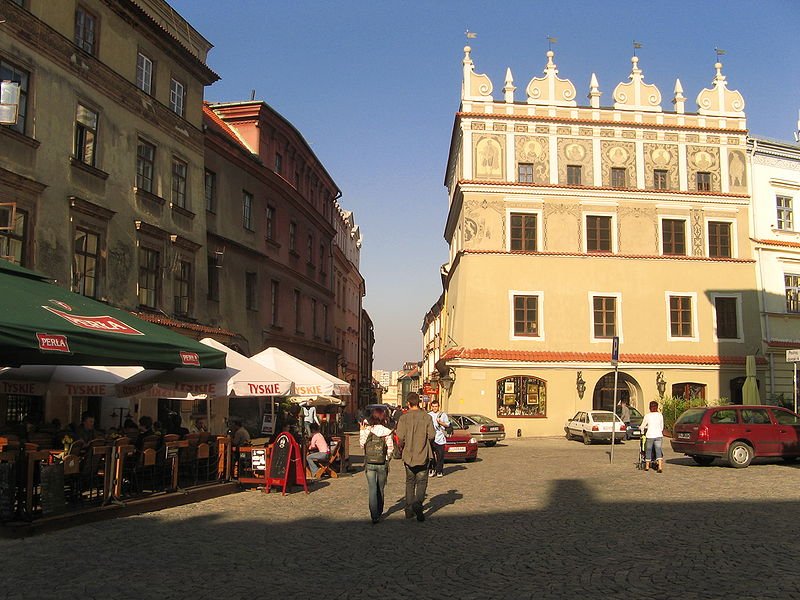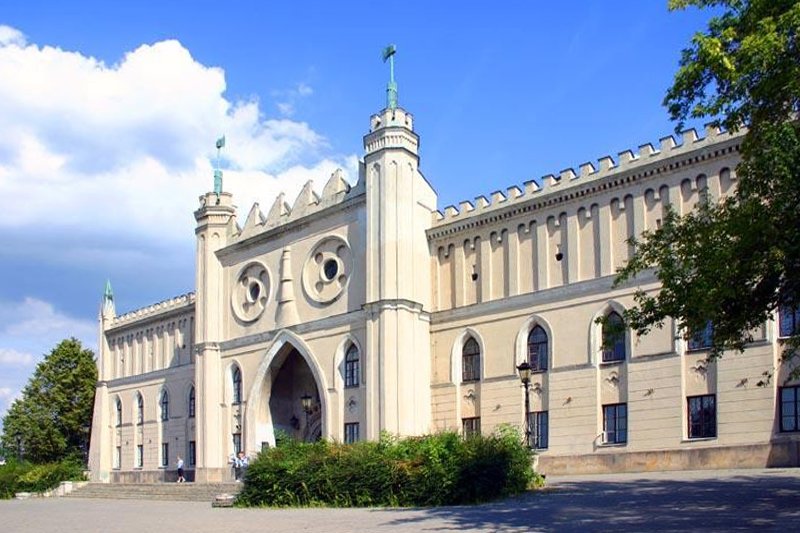 Lublin, Poland
Lublin, PolandSource: https://commons.wikimedia.org/wiki/File:Lublin18395.jpg
Author: Lukaszprzy

Lublin is a city in southeastern Poland. It covers 147 sq km (56.8 sq mi) and has a population of 350,000. The city is best known as the site of the Catholic University of Lublin. The city has an old town with an impressive collection of well-preserved historical buildings.
Although human habitation in the Lublin area goes back to the Stone Age, the first permanent there was established in the early Middle Ages. The area that becomes the present-day Old Town of Lublin was first settled in the 10th and 11th century.
 Lublin Old Town
Lublin Old TownSource: https://commons.wikimedia.org/wiki/File:Lublin_Kamienica_Chociszewska.jpg
Author: Szater

Peace established between Poland and Lithuania in the 14th century helped Lublin to grow rapidly as a trading town. It became the same of the largest trade fairs of the Polish-Lithuanian Commonwealth. That was the golden age of the city which after the 17th century was in gradual decline.
Lublin had one of the most significant Jewish communities in Lublin until the Nazi Holocaust which wiped it out. The only Jewish college in Poland was located there. The Jewish community never reestablish itself after the war, as most of the Jews have left Poland for Israel or Western Europe.
 Lublin Castle
Lublin CastleSource: https://commons.wikimedia.org/wiki/File:Lublin_Castle_5_Lublin_28.jpg
Author: Marek & Ewa Wojciechowscy

The Lublin Region is the poorest part of Poland. Its geographical location away from Western Europe contributes to the isolation. It had the lowest per capita GDP in the European Union until the entry of Bulgaria and Romania in 2007. The cost of living is lower here than in western Poland, making Lublin one of the main receivers of EU development funds.
Visiting Lublin
The most practical way to reach Lublin is to take a train from Warsaw or any other major Polish city such as Wrocław, Kraków, Poznań, Łódź or Gdańsk.Sights & Attractions in Lublin
- Capuchin Church (Kościół Kapucyńw))
Church at Plac Unii Lubelskiej. - Cathedral of Saints John the Baptist and John the Evangelist
Formerly a Jesuit church, the cathedral has an exquisitely rendered interior in the Baroque style. - Church of Our Lady Victorious (Kościół Matki Boskiej Zwycięskiej)
Church established by Władysław Jagiełło to commemorate his victory in the Battle of Grunwald in 1410. - Dominican Church of Lublin (Kościół Dominikanów)
The most majestic church in Lublin, built in the 17th and 18th century but dating back to 1342. - Jewish Cemetery
Remnant of the once significant Jewish community of Lublin. - Kraków Gate (Brama Krakowska)
Medieval gate that is the icon of Lublin. - Lublin Castle
Castle that was first built in the 14th century and remodelled in the Gothic style in the early 19th century, when it served as a prison. Of particular interest in the castle complex is the Chapel of the Holy Trinity (Kaplica Świetej Trójcy). - Lublin Market Square
Main square in the heart of the town, with the town hall next to it. - Lublin Rural Museum
Museum showcasing the rural life in the Lublin Region, with rural buildings and re-creation of small town. - Lublin Town Hall
Civic building that houses the Museum of the History of the Town Hall and the Crown Tribunal of the Kingdom of Poland. - Majdanek State Museum
This was the death camp where the Nazis murdered over 360,000 people. Today the camp has been preserved as a museum and memorial to the victims.
 Latest updates on Penang Travel Tips
Latest updates on Penang Travel Tips
Songs about Penang
About this website

Hello and thanks for reading this page. My name is Timothy and my hobby is in describing places so that I can share the information with the general public. My website has become the go to site for a lot of people including students, teachers, journalists, etc. whenever they seek information on places, particularly those in Malaysia and Singapore. I have been doing this since 5 January 2003, for over twenty years already. You can read about me at Discover Timothy. By now I have compiled information on thousands of places, mostly in Peninsular Malaysia and Singapore, and I continue to add more almost every day. My goal is to describe every street in every town in Malaysia and Singapore.
Copyright © 2003-2024 Timothy Tye. All Rights Reserved.


 Go Back
Go Back